Source: California Invasive Plant Council
URL of this page: http://www.cal-ipc.org/about/staff.php
Staff and Directors
At-large Directors | Student Liaisons | Staff
2011 Board of Directors - Officers
Jason Giessow, President

Jason earned an M.S. in Restoration Ecology from San Diego State University in 1996. He has worked actively on large-scale Arundo eradication and habitat restoration programs in southern California since the mid 1990s. His main priorities are: implementing accurate and inexpensive mapping programs, aiding regional groups in the development of top-down watershed-based eradication programs, and facilitating the development of streamlined permitting. Working with Cal-IPC on expanding the 'Don't Plant a Pest Program' and mapping programs has been particularly rewarding over the past three years. He serves as chair of the Cal-IPC Fundraising committee.
John Knapp, Vice-President

John Knapp is the Board Secretary for the California Invasive Plant Council, and the Director of Native Range Inc., a conservation consulting firm specializing in aerial early detection and rapid response. For the last seven years, he developed and managed the Catalina Island Conservancy's Invasive Plant Program, which targeted 30 species for eradication and 15 species for control. He holds a Masters degree with an emphasis in weed science from Cal Poly San Luis Obispo, and a Bachelors degree in physical geography from U.C. Santa Barbara. His favorite invasive plant is broom, because weed workers can learn a great deal about persistence and diligence from it.
Doug Gibson, Treasurer

Doug was born and raised in Boise, Idaho, where his backyard was literally a river with the foothills and mountains within walking distance. He remembers sitting on the barn roof down the street at age 8, talking with his best friend and making a pact that they would grow up and protect these areas that they used as their natural playground. Fast forward some 30 years and people are still a threat, but now it's not just in the form of development or logging, it's the plants that were brought in and sold that is dramatically erasing the natural landscape. Doug currently occupies space in Encinitas with his wife Lauren and his daughter and son, Heather and Max. He has been the Executive Director / Principal Scientist of the San Elijo Lagoon Conservancy (SELC) for the past 10 years. He has also worked as a private consultant to several resource agencies and NGO's. He earned a B.S. in Ecology from SDSU with a specialty in wetland ecology. He worked for Dr. Joy Zedler at the Pacific Estuarine Research Lab (PERL) for 6 years and did research on the rare saltmarsh daisy, Lasthenia glabrata and the interactions with the invasive brass buttons, Cotula australis. His interests as a Cal-IPC Director include acquiring significant funding through legislative actions for invasive plant work and promoting interaction with other groups with similar interests.
Julie Horenstein, Secretary

Julie Horenstein is Invasive Species Coordinator for the California Department of Fish and Game (DFG). Previously, she was Plant Ecologist for DFG's North Central Region for eight years. Her early career experiences include work as a biologist for an environmental consulting firm, and seasonal stints with DFG's Natural Diversity Database and U.C. Cooperative Extension. She assisted with various research projects in chaparral, coastal sage scrub and vernal pool habitats during and immediately after obtaining her M.S. in Biology from San Diego State University. She obtained her B.A. in Biology from Scripps College in Claremont, CA where she participated in plant community ecology studies in the Mojave Desert. She is currently the chairperson of the California Interagency Noxious and Invasive Plant Committee.
At-large Directors
Edith Allen

Edith B. Allen is a Professor and Cooperative Extension Specialist in the Department of Botany and Plant Sciences, University of California, Riverside. She has a B.S. degree in Biology from Tufts University, and M.S. and Ph.D. degrees in Botany from Rutgers University and the University of Wyoming. Her main area of research interest is restoration ecology, and she has worked in a variety of ecosystem types from boreal forest to tropical forest, as well as shrublands, grasslands, and deserts, including sites disturbed by activities such as mining, construction, grazing, invasive species and frequent fire. Many of these disturbances have severely disturbed soils and have prompted research into mycorrhizal fungi and other aspects of soil ecology. However, the most challenging of restoration problems are those caused by invasive species, and these have become the focus of her research in the past 15 years. Nitrogen deposition originating from automobile emissions increases the productivity of invasive species, and has created another challenge for research and management.
Dr. Allen has published over 100 research articles, and served as an editor for Restoration Ecology and Invasive Plant Science and Management. She has also served on numerous grant review panels for the National Science Foundation, US Department of Agriculture, and other government and university research panels. She is past president of the Soil Ecology Society, and received the professional achievement award from the SES.
Peter Beesley
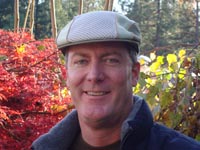
Peter has a bachelor's degree in Ecology from San Francisco State University. Early in his career, Peter was involved with supporting several U.C. Davis research projects looking at plant competition, causes of rarity in endemic species, and rangeland health in Sierran meadows. Currently, he is a Senior Environmental Specialist with Pacific Gas and Electric Company and is responsible for managing PG&E's Valley Elderberry Longhorn Beetle Conservation Program. He is in the process of developing a comprehensive noxious weed management program for the utility. Through this effort he became involved with CAL-IPC and is looking forward to getting more involved with supporting their mission, developing best practices for utilities, and increasing participation in Weed Management Areas and with early detection networks.
Jason Casanova

Jason is the Staff Cartographer for the Los Angeles and San Gabriel Rivers Watershed Council, where he manages their GIS database, provides GPS services/field data collection in support of Council projects/initiatives, and handles the map production requests for Council staff and stakeholders. Currently, he is assembling a comprehensive invasive plant GIS database for Los Angeles County as well as working in partnership with other regional WMA participants to compile a standardized Arundo donax dataset for southern California. Related past projects include assisting in mapping Arundo along the Los Angeles River and tributaries. Additional ongoing projects include assisting in the development of the Tujunga Wash Watershed Management Plan, assembling a historic aerial photography database to facilitate the identification of historic wetlands along the San Gabriel River, and supporting the formation of a native seed bank database for the San Gabriel River.
Edmund Duarte

I am a Bay Area Native and work as a Senior Agricultural Biologist for the Alameda County Department of Agriculture. I have assisted in co-administering of the Alameda Contra-Costa County Weed Management Area for approximately 5 years. I earned my Bachelor’s Degree in the Biological Sciences 1996 from U.C. Davis, and also a Master’s Degree in the Biological Sciences from CSUEB in 2002. My interests in the life sciences are broad, with emphasis in evolution and ecology, including; nematology/marine invertebrate and vertebrate zoology, alien/invasive ecology, botany, and physical anthropology. For my master’s thesis I conducted an ecological field study (1st ever) of a free-living nematode community of San Francisco Bay. I also concurrently teach a course in Electron Microscopy at Ohlone College in Newark, CA. I’m honored and very excited to be part of the Cal-IPC board this year, and to have the opportunity to work with such an amazing group of people working toward positive change in our environment. Here’s to a great year combating invasives in 2011!
Valerie Eviner
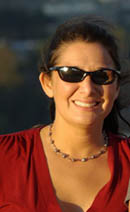
Valerie Eviner is an Assistant Professor of Restoration Ecology and Ecosystem Management in the Department of Plant Sciences, University of California, Davis. She has a B.A. from Rutgers University, and a PhD from University of California, Berkeley. Her research focuses on understanding the mechanisms regulating plant-soil interactions and applying this understanding to ecosystem management, restoration, invasion control, rangeland management, and global change issues.
In particular, her work explores the potential to manage for a balance of multiple goals, including: controlling multiple invasive species, enhancing ecosystem services (e.g. diversity, water flow, erosion control, nutrient supply), and accommodating human uses of land in California. This work is accomplished through active collaborations with multiple NGOs, government agencies and private land owners.
Kim Hayes

kimsteward.ship@elkhornslough.org
My professional experience has allowed me to enjoy the fun and learn from the challenges of working in both wildlands and in the wildland/urban interface. For the past nine years I have been the Stewardship Director for the Elkhorn Slough Foundation, a land trust in the central coast. I oversee the management of nearly 4000 acres of lands. My colleagues and I focus our control efforts on 15 invasive weed species in terrestrial and wetland habitats. I have been an active participant in the Monterey County Weed Management Area since its inception. Some of my past work experience includes working with the University of California’s Natural Reserve System, State Parks, and the Wildlands Restoration Team.
As a dedicated natural lands manager, I maintain a strong, multi-disciplinary approach to invasive species control. I know very intimately the challenges to controlling particular weeds, and yet I have been able to celebrate successes with colleagues when we have reached our eradication or control goals. I also have extensive experience working on outreach, education, and policy work that sometimes seems very slow to succeed. As a member of Cal-IPC, I have participated in Cal-IPC’s “Day at the Capital.” These experiences help me to know that Cal-IPC’s work needs to be intelligent, steady, and focused in many arenas in order to make a lasting difference.
The Cal-IPC program areas I am most interested in working on are dedicated to strengthening policies and programs focused on weed management in California and enhancing the knowledge and skills of the state’s resource managers. Following a tradition within Cal-IPC’s board, I offer extensive lands management experience, and I compliment that with strong interdisciplinary knowledge of policy and program implementation that can strengthen Cal-IPC as its programs grow.
Sue Hubbard

Sue Hubbard was born and raised in England but has spent most of her adult life in California. She started controlling invasive plants as a volunteer for the Golden Gate National Recreation Area Habitat Restoration Team. After obtaining a B.S. in Biology (with a concentration in Ecology and Systematics) from San Francisco State University, Sue returned to the Habitat Restoration Team as an intern and attended her first Cal-IPC conference (Asilomar in 1995). Sue has had a number of jobs including implementing riparian restoration projects in Big Sur and the Lassen foothills, mapping invasive plants in Lassen National Park and studying birds in Oklahoma. She has been in her present position with the Federal government for 11 years. She is responsible for invasive plant control on 15,000 acres, including areas which are off limits to the general public because of the potential presence of ordnance. She has been involved with the Monterey County Weed Management Area including being on the organizing committee for the Central California Invasive Weed Symposium.
Deb Jensen
Bio coming soon.
Brent Johnson
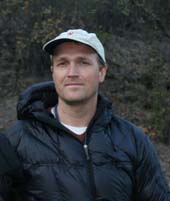
Brent has now been seeking out invasive plants throughout California for nearly fifteen years. It was back then while working on invasive plant surveys in Sequoia and Kings Canyon National Park that he first realized that those emerald green hillsides of grasslands were covered with non-native plants. He hasn't been able to look at those hillsides the same way since. After reluctantly leaving the Sierra Nevada, Brent went to graduate school at Sonoma State University where he examined the effects of reintroduced tule elk on coastal prairie grasslands in Point Reyes National Seashore. He soon returned to the Sierra where he managed a number of invasive plant projects in Yosemite National Park. This included developing a parkwide invasive plant management plan. Currently Brent works in Pinnacles National Monument where part of his responsibilities are to oversee the invasive plant program. This new position includes taking on a formidable population of yellow star-thistle. His research and management interests include plant-animal interactions and incorporating traditional ecological knowledge into park restoration efforts by collaborating with Native American tribes.
As a Cal-IPC Board member Brent helps explore ways that Cal-IPC can expand its capacity as an information clearinghouse for invasive plants, and explore ways that Cal-IPC can assist in providing a regional perspective to some of our worst invaders in California.
Shawn Kelly
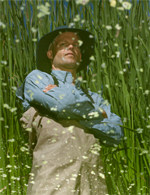
Shawn has a B.S. in Ocean Engineering from Texas A&M University and a Masters in Environmental Science and Management from the University of California, Santa Barbara. Shawn is a Program Manager for the Southern California Wetlands Recovery Project, a partnership of public agencies working cooperatively to acquire, restore, and enhance coastal wetlands and watersheds in coastal southern California. Shawn has overseen over 100 projects in the WRP’s Community Wetland Restoration Grant Program. One of the primary restoration activities funded is invasive plant removal, and these efforts have illustrated the impacts from invasive vegetation and the opportunities and challenges in removing these harmful plant types from California’s riparian and wetland habitats.
In working to remove invasive plants, Shawn has participated in discussions exploring such topics as assessment, native plant revegetation, regulatory and policy issues, research needs, project funding, and source control, both through legislation and education of consumers and nurseries. He is interested in the policy issues related to invasive plant removal in small scale, community implemented restoration projects and the education opportunities presented therein. Shawn would like to see an increased effort on source control and sees education on invasive plants as critical to accomplishing this goal.
Shea O'Keefe
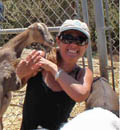
I received both my B.S. in Biology (emphasis is Zoology) and my M.S. in Evolutionary Biology from San Diego State University. My graduate work assessed wildlife corridor functionality in San Diego using non-invasive sampling methods and population genetics.
I am a third generation native of San Diego County and have found that enhancing and restoring the small amount of remaining open space, and improving the situation for the many sensitive species listed in the county as one of my passions.
I was hired by the NRCS in October 2004 as the biologist for southern California. Currently I manage many projects under several NRCS programs, primarily the Wildlife Habitat Incentives Program and the Wetland Reserve Program. I also oversee environmental compliance for all federally funded NRCS projects within the lower four counties of southern California. These programs have provided the financial opportunity to address sensitive habitat restoration and the eradication of many types of invasive plants on large scale, watershed-level landscapes that include both private and public lands.
Through the Emergency Watershed Program, I have also responded to two major wildfires in southern California (2003 Cedar fire and 2007 Witch Creek, Harris, Poomacha and Rice fires) in terms of erosion control, water quality and overall vegetation management.
Through the short time-frame of 5 years working with NRCS, there has been a continued success of invasive weed control and restoration of sensitive habitats which has facilitated successful partnerships with regulatory agencies, local governments, land conservancies and private landowners.
Peter Schuyler

As a 3rd generation Californian, Peter has been fortunate to live in a variety of California's urban, rural and wild (my favorite) places. He has watched as our state's natural resources and areas face an onslught of threats and challenges, thus he has focused his career on ways to protect natural areas through both threat prevention as well as restoration.
Peter received a B.A. in Geography from UC Santa Barbara with a focus on botany and a masters degree in Conservation Biology from the Yale School of Forestry and Environmental Studies concentrating on the impacts and effects of invasive species from both a policy and applied perspective.
In the 1980's Peter worked as The Nature Conservancy's preserve manager/director on Santa Cruz Island and was involved with all aspects of managing a 60,000 acre natural area, including developing and implementing invasive species control programs. In addition, Peter was involved with TNC's presecribed fire program throughout California.
In the 1990's as the Program Manager for the State of Hawaii's Natural Area Reserve Program, he had the opportuity to develop programs addressing both highly endangered species as well as invasive plant and animal issues fromthe halls of the State legislature to the slippery volcanic slopes.
As the millennium came and went, Peter spent 8 years as Director of Ecological Restoration building and implementing conservation programs on Catalina Island. Their programs were able to successfully address a number of controversial resource managmenet issues, including recovering the endangered island fox from the brink of extinction, removing a number of invasive animal species and developing a framework to better understand the island's natural resources through a research and monitoring program. Throughout his tenure, Peter worked to elevate the understanding for the neeed for a long term, systematic invasive plant control program. By the time he left, they had mapped and ranked the invasive weeds of the island and intitiaed a program to secure long term fuding and staff to address control of highly ranked species.
Most recently, Peter has been back in his hometownof Santa Barbara, doing occasional environmental consulting work, participating on the boards of and volunteering for local environmental organizations, and figuring out my next consevation career objectives.
Andrea Williams
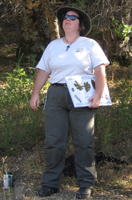
Andrea began her weed work in earnest during college, studying English ivy in Pacific Northwest forests as well as species composition of a coastal prairie in Oregon. She started in professional land management with the National Park Service at Redwood National & State Parks in 2000, and returned in 2005 to the Bay Area where she was born and raised.
Her areas of expertise include mapping, early detection and rapid response, and strategizing for effective weed management at various scales. She was the primary author on “Early detection of invasive plant species in the San Francisco Bay Area Network: A volunteer-based approach” and co-founder of the Bay Area Early Detection Network, and has taught several classes related to mapping, early detection, and weed identification. Her current work with Marin Municipal Water District involves overseeing the invasive plant program, including over 1,000 acres of broom and numerous other weeds, as well as monitoring and managing forest succession in light of the effects of Sudden Oak Death.
Student Liaisons
Chelsea Carey

Chelsea Carey received a B.S. in Biology and Environmental Science from DePaul University in 2008 and is now a third-year Ph.D. student in the Environmental Systems Program at UC Merced. Her research looks at the interactive effects of global change factors on plant-soil interactions. Specifically, she is interested in how invasive plants (Barb goatgrass, Medusahead, and Yellow starthistle), nitrogen deposition, and livestock grazing affect the soil microbial community and ecosystem functioning (i.e. nutrient cycling).
Chelsea spent time in between her B.S. and Ph.D. working as a conservation biology intern for Lake Forest Open Lands Association, a non-profit land trust in Illinois, and also as a research assistant for the Chicago Wilderness Land Management Research Program. Her interests in invasive species ecology and management stem from her undergraduate research on European buckthorn and her experience working with land management projects. She has been a member of Cal-IPC since 2009.
Kai Palenscar

Kai Palenscar is a fifth-year Ph.D. student in the Botany & Plant Sciences Department at UC Riverside. Currently he is investigating the management of giant reed (Arundo donax) and restoration of riparian ecosystems within southern California. Specifically, he is interested in the biotic and abiotic factors which play roles in A. donax establishment, and the role restoration plays in long-term management.
After earning a B.S. in Biology from California State University, San Marcos in 2002, he worked for several years as a private consultant on restoration projects in Southern California which fueled his desire to provide research relevant to land managers. In 2007, he was one of the founding members of the Student Chapter of Cal-IPC, where he has participated in outreach to the public about invasive plants, volunteered during weed pulls, and led a group to Catalina Island partnering with the Catalina Island Conservancy on several projects. He currently serves the Student Chapter as co-chair and as a Student Liaison to the Board of Directors.
Staff
Doug Johnson, Executive Director

Doug became Cal-IPC's first staff person in 2002. He holds an M.A. in Geography from San Francisco State University with an emphasis on conservation biology, GIS, and perceptions of wilderness. He was awarded a Switzer Fellowship for Environmental Leadership. Doug also holds an M.S. in Mechanical Engineering from Stanford University. He has worked in wildland weed control with California State Parks and The Nature Conservancy, and as a private consultant. Other work experience includes municipal energy conservation, engineering design, environmental education, and production of educational science exhibits for museums. Doug serves as chair of the California Invasive Species Advisory Committee; as vice-chair of the National Association of Exotic Pest Plant Councils; and on the steering committee for the California Horticultural Invasives Prevention (Cal-HIP) partnership.
Elizabeth Brusati, Science Program Manager

Elizabeth joined Cal-IPC in 2004 after finishing a Ph.D. in Ecology, with an emphasis in Marine Ecology, at UC Davis, where she compared how native cordgrass and invasive hybrid cordgrass affect salt marsh invertebrates in northern California estuaries. She received a Canon National Parks Scholarship for her fieldwork at Point Reyes National Seashore. She also holds an M.S. from Texas A&M University and a B.S. from UC Davis, both in wildlife biology. Her research experience has moved down the food web from raptors to shorebirds to intertidal invertebrates and now plants.
Alice Chung, Training Program Specialist

Alice joined Cal-IPC in 2011 as a Training Program Specialist. Her focus is on the development of Prevention Best Management Practices, and a certification program for Invasive Plant Managers. Prior to joining Cal-IPC, she worked as a landscape architect with project experience ranging from garden design, campus planning to park and open space development and preservation. Alice has a passion for community based projects that take people outdoors and foster curiosity about our natural world.
Heather Brady DeQuincy, Outreach Program Manager

Heather joined Cal-IPC in 2008 and focuses on outreach efforts, including Wildland Weed Field Courses, the Speaker's Bureau, and the PlantRight Campaign. Previously she worked for The Big Sur Land Trust stewarding properties and relationships within Monterey County, and as a consulting botanist in Northern California. Heather has a passion for investigating ecological interactions, ethnobotany, and urban forestry. She is happiest when wildland weed projects occur under the canopy of trees or beneath dense coastal fog.
Ginny King, Program Assistant

Ginny began her work at Cal-IPC as a temporary Program Assistant in 2008. This year she was called back to work half-time permanent in the same capacity. Ginny's background is in administration and holds a MSW in Administration from Catholic University in DC. Most recently she worked with Build It Green, where she worked to promote healthy, energy- and resource efficient building practices in California. Her passion is care of Earth and her desire is to work in the area of sustainability and ecology. Ginny has been a California resident for 18 years, coming from Detroit MI by way of Memphis TN.
Agustín Luna, Business Manager

Agustín is an administrative manager with over 19 years of experience. He has worked with professional non-profit arts organizations like the Hollywood Bowl, Cal Performances, South Coast Repertory, and now Savage Jazz Dance Company, as their Company Manager. Agustín has also worked with and taught college students in UC Berkeley’s Student Music Activities Department and high school students in Oakland School for the Arts charter school the essentials and fundamentals of arts administration including artist-presenter management, fiscal management, development, and front-of-house/box office management. Recently, Agustin was the General Manager, previously the Operations Director, of Movement Strategy Center, where he oversaw the finance, human resources, IT, operations, facility management, and the fiscal sponsorship program of the organization.
Agustín is also an avid salsa dancer and instructor, and is the occasional presenter of salsa events through his company Agustín Luna Presents. He has danced Bomba y Plena with Bay Area Boricuas, assisted them in their initial organizing as a 501(c)(3) nonprofit corporation, and briefly served as their Managing Director. Agustin is one of the last beneficiaries of California’s elementary school music program and has played his trumpet continuously since 1982. He hopes that music in the schools does not disappear and supports efforts to keep it alive.
Bertha McKinley, Program Assistant

Bertha began as a volunteer in Cal-IPC's office, helping with administrative tasks. She is now a part-time staffperson. She serves as our "master of fulfillment", processing orders and memberships and helping with many projects. Bertha moved to the Bay Area after many years in Southern California, where she was president of the San Diego Chapter of the California Native Plant Society. She now volunteers her time to the East Bay CNPS and enjoys gardening with native plants.
Dana Morawitz, Mapping Program Manager

Dana joined Cal-IPC in March 2010 to lead the ARRA-funded statewide invasive species mapping program. Prior to joining Cal-IPC, she worked at an environmental consulting company where she focused on Caltrans projects and realized that she prefers more fulfilling work like pulling weeds and mapping statewide species distribution. Previous experience includes spearheading GIS in support of countywide fire planning in Telluride, CO, and working as a remote sensing analyst on tsunami relief efforts for MercyCorps. She holds a Master's degree in Geography from the University of Washington where she focused on urban ecological issues. Her particular focus investigated the spatial and temporal patterns associated with the transition of forested to urban lands over 15 years. Dana brings exuberance to her work and has a strong desire to protect wildlands. Botany and ornithology are two recently adopted hobbies. She is keen on learning new species but plans to stick to common names for now. She must go latin for the family names though, so quiz her on those! Dana is keen to broaden her knowledge to other threats at the wildland urban interface in this role at Cal-IPC.
Tony Morosco, Mapping Specialist

Tony Morosco began as Invasive Plant Mapping Specialist at Cal-IPC in 2011, focused on collecting quality spatial data on invasive weeds. As a student, he worked at the University and Jepson Herbarium for four years, graduating in Integrative Biology in 2008. Tony co-founded and developed Calflora.org from 1997 to 2003, amassing and integrating a large collection of information on native and non-native wild California plants from multiple collaborators. Tony worked at San Francisco Botanical Garden as Curator of Living Collections from 2003 – 2007, where he cultivated an invasive species monitoring policy to prevent the spread of new invasives before they start. Tony served as CNPS East Bay chapter VP and President for four years, and board member for California Botanical Society for two years. Tony also works part time as a biodiversity informatics consultant specializing in developing botanical databases with web integration, and curation of botanical gardens. Tony lives in Santa Cruz, and spends his free time gardening, cooking, botanizing, hiking, camping (near hot springs, when possible), and photographing plants.
Cynthia Powell, Mapping and Modeling Specialist

Cynthia joined Cal-IPC in 2010 as our Mapping and Modeling Specialist. After graduating with her bachelor's from Carleton College in neuroscience, she is now an MS candidate in Geography at San Francisco State University. For her thesis work she is modeling Pardee Reservoir water supply using satellite images with an emphasis on resource management, GIS, modeling, and remote sensing. For Cal-IPC she is using her modeling and quantitative analysis background to examine change in invasive species habitat with different potential climate change scenarios. Other work experience includes water supply modeling based on satellite imagery of snowpack, urban accessibility mapping for East Bay Regional Parks, mapping for San Francisco's Neighborhood Parks Council, and co-owning a small business in Berkeley.
Falk Schuetzenmeister, Mapping and Modeling Specialist

Falk joined the Cal-IPC science and mapping team as a specialist in survey methodology, statistics, modeling, and online mapping. He earned his PhD in Sociology from the Dresden University of Technology, Germany and worked for two years as a postdoctoral fellow at UC Berkeley. In his PhD and postdoctoral work, he studied the social organization of expert communities in climate research and life sciences. He paid special attention to the role of numeric modeling in modern research and the resulting effects on data collection, sharing, and communities. He also studied the increasing importance of local/expert knowledge in biodiversity research and governance. Falk is excited to apply his knowledge in the fields of science studies and environmental sociology in a very practical context. Before his more theoretical academic journey, Falk was engaged in the protection of amphibians and reptiles. In 2007, Falk moved to the US and loves to travel around California especially if it serves the important purpose of protecting its amazing wild land and biodiversity.
Arpita Sinha, Training Program Specialist

Arpita Sinha joined Cal-IPC in 2010 as the Training Program Specialist. After graduating from UC Berkeley in December 2009 with a degree in Integrative Biology and Spanish, she went to Costa Rica to conduct research on the mutualism between Cordia alliodora (a native tree) and its associated ants. Her favorite topics in college were botany, ecology and plant systematics and she has always been fascinated by the interactions between plants and the environment. Her previous experience includes developing a research training program at a national women’s reproductive rights organization, teaching a computer class in Spanish to women in Santiago de Chile and performing wetland restoration next to the San Francisco Bay. Her other interests include organic gardening, cooking Indian food and craft making.
Jen Stern, Training Program Manager

Jen joined Cal-IPC in 2010 as the Training Program Manager. Her focus is on expanding the field course program, developing curriculum, and reaching new audiences. Previously she worked for the Resource Conservation District of Santa Cruz County managing conservation projects, and developing a variety of educational events including technical trainings. She has a M.S. from CSUMB in Coastal Watershed Science and Policy and a B.A. from UC Santa Cruz in Environmental Studies and Community Studies. Jen has a zeal for expanding the weed warrior community and eradicating weeds in new and collaborative ways.
